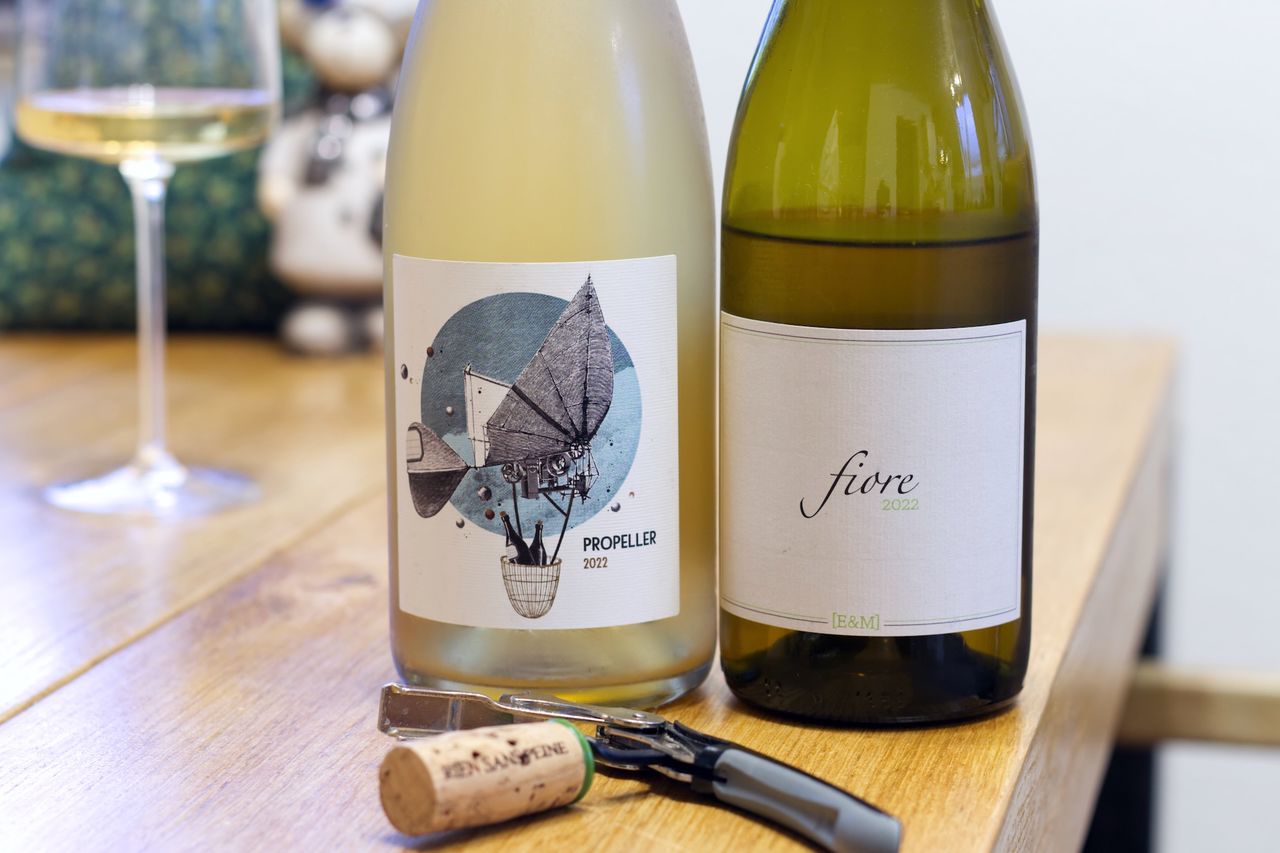Enderle & Moll and [trub:stoff]
For the start of december we drink two wines from the Moll family. A bottle of Kerner fiore 2022 from Enderle & Moll and a PetNat Propeller 2022 from [trub:stoff].

The label on the cork has remained the same, yet much has changed since the last bottles we tried from the Enderle & Moll winery here. That was over three years ago. It’s really crazy how time flies. In 2020, Sven Enderle made the decision to take on new challenges. In the years prior, Géraldine, Florian Moll’s partner, had already joined the growing operation. To support in the cellar, Maxence Lecat, a cellar master from France, also became part of the operation during this time. Manfred and Leonie Enderle, who initially only supplied grapes, now jointly cultivate the vineyards and have become an important part as well. So, a lot has changed in recent years. What remains unchanged is the association of the winery primarily with Pinot varieties. That’s why today we’re drinking Kerner, and I promise that it will make a lot of sense. Firstly, despite thinking really hard about it, I cannot recall having had a bottle of Kerner in recent years and wanted to change that. By the way, Kerner was bred from Trollinger and Riesling in Württemberg, so if you’re from Württemberg like me, I thought it makes sense to at least give it a try. Secondly, three natural wines, named Prestige, are now part of the winery’s assortment, and by coincidence, one of them is this Kerner fiore from 2022. To make the story perfect, Florian and Géraldine have started filling PetNats under the label [trub:stoff], and, as you might guess, one of them contains Kerner alongside Weissburgunder. Apart from that, they stick some of the best labels on these bottles that I have seen in the last year, and for those who have been reading here for a while, you know I had to grab them just for that reason alone.
The fiore grows on shell limestone, undergoes spontaneous fermentation, and then spends a long time on the fine lees before ending up in the bottle unfiltered and unclarified. Under one of those alibi wax blobs that, when they grow up, surely wanted to become a whole wax capsule. Such a pity that my surely very funny play on words regarding wax and growing doesn’t work out in english at all. However, what this blob lacks in surface area, it more than compensates for in tenacity. It was a real challenge to push the corkscrew through it. Wax on wine bottles and I, that’s just not going to be a love story anymore. The Kerner then starts very nutty in the glass. The better half then mumbles something about elderflower syrup and whether a Hugo cocktail fell into the glass. And now that she says that, I smell it too. I find the first moments a bit demanding, but she sees it very differently. The wine is cool and very straightforward with a lot of juicy tension. There is peach and some lemon, but it’s actually rather low in fruit. This is one of those wines where what you smell and what you taste doesn’t quite seem to match, but the combination is still really good. With more air, it becomes more natural on the nose, dirtier, and a bit woody. And somewhere behind that, very lightly, is also a touch of wild acidity that cleans up the back of the tongue.
The next day, the wine is wilder. More natural, somewhat less clean, and the acidity a bit more demanding. Everything comes closer together as there is smoke, glue, oranges, and quinces. Even more air brings back more fruit. It becomes creamier, constantly changing, now reminiscent of juniper and mirabelles. When drinking, the wine is creamy yellow and full of apple peel. I don’t even bother asking how typical this is for Kerner. Firstly, because it’s quite natural, and the question of varietal typicality becomes much more difficult there, and secondly because I have no idea what typical Kerner would actually be. What I can say, though, is that this is the best Kerner I have ever tasted. Whatever that’s worth.
We take the Propeller at its word and spin it around its own axis several times before the crown cap has to yield. So if you prefer your PetNat without shaken yeast, don’t put too much trust in the following words. It’s slightly cidery but at the same time very clean. Of course, it also smells like yeast. There’s citrus, more pomelo and grapefruit than lemon or lime, and a good dose of stone fruit. A bit like an orchard on the nose and also on the palate. There’s very fresh apple and a lot of tension. Depending on whether you get a hazier glass or one with less yeast, it’s sometimes wilder and sometimes less wild. Like the still wine on the second evening, more air here brings more fruit again. There’s sweet pear, and especially when drinking, there’s also Orangina. It instantly jumps onto the podium and is the second-best Kerner (with Weissburgunder) I have ever tasted. And for me, that’s quite valuable.